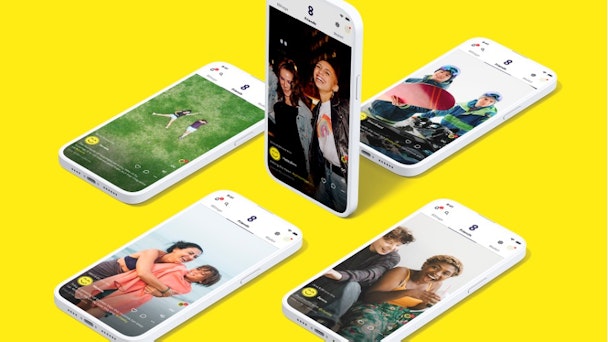WeAre8 will pay you to watch ads in the name of saving the planet
We catch up with Sue Fennessy, founder of the social media app that pays you to watch ads, to hear why she thinks this model is better for people and for the planet.

WeAre8 pays users to watch ads and donates a percentage of ad revenue to charity / WeAre8
Australian-born Sue Fennessy has spent the last 30 years at the coal face of digital media. After creating the data aggregation tool Standard Media Index, she says she became increasingly frustrated by the lack of effectiveness of digital media platforms and the increasingly negative impact of social media on our day-to-day lives.
Her next endeavor, the social media app WeAre8, was born after asking herself one question: “The world is on its knees, so how can we reimagine a digital ad model that gets people’s full attention and leaves them feeling really valued and loved?”
According to Fennesy, Standard Media Index was able to correlate that Meta drew in $117bn in ad revenue in 2020, but only delivered an average engagement rate of 4%. It is her opinion that advertisers have “taken a TV ad, jammed it into digital and never really reimagined it,” and as a result, she says, “humans have a shorter than ever attention span and we’re just followed and bombarded”.
At WeAre8, Fennessy says the team has created a social media tech platform “with zero tolerance for hate and that’s good for the planet,” giving users the option over whether or not to engage with ads, allowing them to redirect the money they earn from engagement to causes they care about, and all on a platform with a policy of zero tolerance for hate and zero brand presence from big oil, tobacco and gambling firms.
Advertisement
So how does it work?
Fennessy says that, from a user experience, WeAre8 is “like Instagram and TikTok had a love child with Change.org and GoFundMe”.
What’s grabbed the most headlines so far is that WeAre8 pays its users to watch ads. With an opt-in approach to pop-up ads, Fennessy believes that handing the choice of whether or not to engage back to users leaves them feeling more valued, but also improves engagement for brands spending on the platform. “95% of people watch the ads, but we don’t jam them on to your feed.”
Research by Lumen into ad effectiveness on the platform found that half of all impressions on the app gain at least 10 seconds of attention, compared with just 10% of nearest competitor YouTube’s ads.
Once users have opted-in, Fennessy explains, they are shown the 30-second clip and potentially asked several questions about the experience. She says this is a win-win for users and advertisers as brands can learn in-depth about the customers that choose to engage with them, while users can decide whether to give the small amount of cash they receive to nominated charities (which include partners such as Unicef and the Great Barrier Reef Foundation) or to keep it for their own use. “Every time you watch an ad, a donation gets made to a charity or goes in little micropayments directly into your wallet. You can use them to pay your Spotify subscription, your phone bill, whatever. We’re putting people at the heart of the economics.”
Advertisement
But the story doesn’t end at viewing stats, with Lumen stats revealing that brand favorability goes up significantly on WeAre8 too – around a 19% increase on average. “If you choose to watch an ad, our research over many years with behavioral scientists tell us you remember it better – up to 83% of people go on to recall the ad after engaging with it and answering a few questions.
“It gets 26 times more engagement than an Instagram feed video, 17 times more engagement than a Facebook feed video, nearly four times more attention than a YouTube non-skippable ad. It’s powerful.”
For brands, investing in this high-engagement model on a purpose-driven and safeguarded platform will doubtless appeal as many are increasingly boycotting some of the major platforms, including Meta and Google, over concerns about the spread of misinformation and the monopoly big tech has on the social media app market.
Suggested newsletters for you
But Fennessy adds that the model is inherently more sustainable as it drives down the carbon emissions produced by a proliferation of ineffective ad impressions.
Research by Scope3 previously revealed the excessive carbon emissions caused by clickbait and made-for-advertising sites. Fennessy says, therefore, that the increased engagement with ads by WeAre8 users is not only better for brands but for the planet. “We’re not just throwing out thousands of ad impressions to see if one sticks.”
But, she explains, WeAre8 isn’t just trying to reimagine the social media ad model. It is trying to change the way we use social media – for the better. “You can still tweet on Twitter and dance on TikTok, but you can change the world on WeAre8.”
For one, the platform doesn’t track users’ engagement on anything but the ads they choose to watch. “We believe personal data should stay personal and only be used for your best interest. So when people are using our social feeds, we don’t follow them.”
It is also certified B Corp and doesn’t accept any money from big oil, firearms, tobacco or gambling, nor does it take any political advertising. “We’ve got a higher bar than any of the other media channels.”
Fennessy goes on to say that the three separate feeds the app features – for brands, content creators and users – also allow people to be more selective with the content they see and to reconnect with the personal aspects of sharing and creating posts. “People might start coming to us because they want to see exclusive content from a creator they like, or they might just want to see their friends on their feed again.”
Who’s it for?
The app is still in its adolescence. On the user side, Fennessy says, it’s “well on its way to a million installs in the UK,” and it hopes to be there by August.
Users tend to be young and affluent, with a quarter of them based in London. Many of them are also drawn to the app because of its more positive environmental impact, with 89% of users saying they make purchase decisions based on environmental impact.
While the app has been able to recruit a number of the country’s leading brands, from major supermarkets to leading retailers such as John Lewis and FMCG giants including Dove, The Body Shop and L’Oreal, the question remains whether the high investment for a high-efficiency ad model on the platform will lead to success for all brands.
Whether the major players will fully migrate to the app remains to be seen, but for purpose-driven brands looking to meet their target market where they are, it could spell success for early adopters. As Fennessy concludes: “We are united by a mindset and we’re on a mission.”
Want to learn more about the most important issue of our time? Senior reporter Ellen Ormesher will explore the role advertising and marketing play in facilitating the climate crisis. Case studies, tips, interviews and more. Register your interest here.

